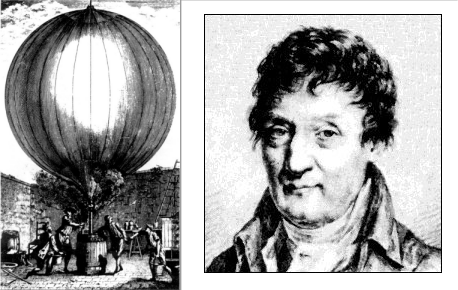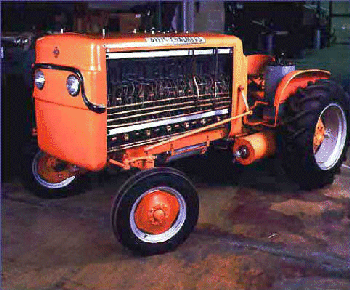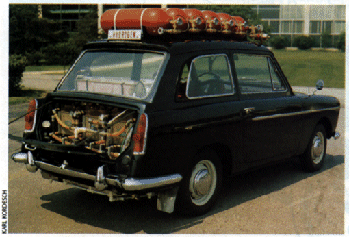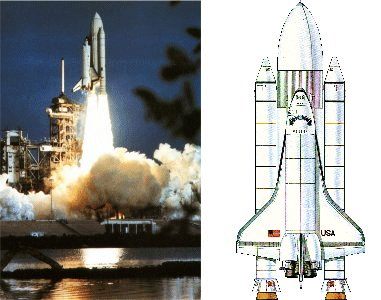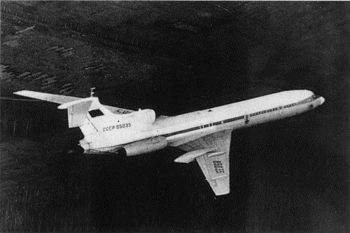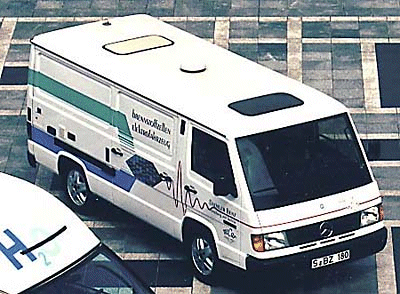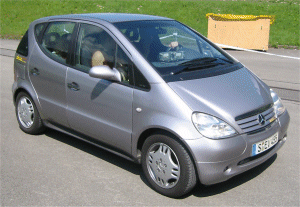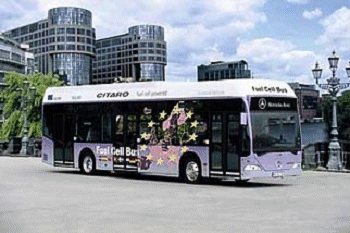Hydrogen transport
Hydrogen in Transportation
Cavendish, who called hydrogen “inflammable air”, was also the first to measure its density. He reported in his 1766 paper that hydrogen is 7 to 11 times lighter than air (the correct value is 14.4). Cavendish’s results not only opened up a new chapter in the history of gases, but also attracted attention to hydrogen as an alternate to hot air as a buoyant gas. Jacques Alexandre César Charles was first to take advantage of this, soon after the first public demonstration on 5th June 1783 of a hot-air balloon by the Mongolfier brothers.
Fig. Jacques Alexandre César Charles was first to take advantage of hydrogen as an alternate to hot air as a buoyant gas, soon after the first public demonstration on 5th June 1783 of a hot-air balloon by the Mongolfier brothers.
After four days of struggling with his ironacid hydrogen generation equipment, Charles launched his 4-meter balloon on 27th August 1783. Just over three months later, he and one of his balloon builders, Aine Robert, became the first men to ascend in a hydrogen balloon. With all the enthusiasm over -ballooning that began with the Mongolfier brothers and Charles in 1783, it was inevitable that the good and bad properties of hydrogen would meet. The worst happened on 15th June 1785 when Pliatre de Rozier and an assistant, P. A. Ronaon, attempted to cross the English channel in a hydrogen balloon carrying a small hot-air balloon for altitude control. Thirty minutes into the flight the hydrogen ignited and the two men perished. Hydrogen’s flammability was the underlying cause of the first air tragedy. Nevertheless, the attractiveness of hydrogen as a readily available buoyant gas was to outweigh the danger of flammability for 150 years of lighter-than-air flight. The Hindenburg diaster 6th May 1937 in Lakehurst ended the air applications of hydrogen after 150 years.
The air application of hydrogen is the reverse of hydrogen’s later role as a fuel, where its flammability is a major advantage and its low density the disadvantage that inhibits its use for flight in the atmosphere. Experiments using hydrogen as an engine fuel had already been carried out in 1820 by W. Cecil. These experiments were followed by investigations in car engines up until the 2nd World War and partly afterwards (Ricardo, Burstal, Erren). Various transport systems using hydrogen were tested, e.g. in the USA by. R. Billings or in Germany (Daimler Benz, BMW) in the last decade of the 20th century. The potential of hydrogen as an aviation fuel was established 1957 with the lift-off of a hydrogen-powered B-57 Canberra twin-engine jet bomber. From 1963 on liquid hydrogen liquid oxygen propelled rockets were launched. For the Apollo moon flights 12·103 m3 of liquid hydrogen were necessary to tank the Saturn carrier rockets.
Fig. The Saturn series of launch vehicles are large-scale rockets developed for NASA’s Apollo lunar landing program. This type of rocket was originally proposed by Wernher Von Braun in 1957, who at that time was assigned to the Army Ballistic Missile Agency (ABMA). Following its establishment in 1958, Von Braun and other U.S. Army scientists were transferred to NASA, with the Saturn rocket development program subsequently becoming a NASA endeavor. The first test launch of the Saturn V took place in November 1967. In December 1968, the third Saturn V to be launched sent Apollo 8 around the Moon. The sixth Saturn V launched on July 20, 1969 propelled Apollo 11 to the Moon for the first successful manned landing on the lunar surface. The Saturn V rocket was used for subsequent Apollo missions to the Moon. With termination of the Apollo program after the Apollo 17 mission, however, three Saturn V rockets out of the total of 15 produced remained unused. Of these, one was subsequently used to carry the manned Skylab 1 (space station) mission into space. The remaining two unused versions of the Saturn V are now on display to the public. Saturn V
In 1959 the first fuel cell vehicule a Allis Chalmers D-12 (weight 1270 kg) equiped with an alkaline fuel cell delivering a power of 15kW (4 Stacks with 252 Cells each) was demonstrated by ploughing a field. The fuel was propane stored as compressed gas in a pressure vessel.
Fig. Allis Chalmers D-12
In 1967 a six-passenger electrovan from GM was the first operational fuel cell powerd electric vehicle (weight 3400 kg). The fuel cell from Union Carbide with top output of 5 kW was fueled with liquid hydrogen giving the electrovan a range of 200 km and a top speed of 105 km/h. For safety resons the vehicle was only used on company property; trating time was sometimes prolonged to several hours, fuel cell life was only 1000 h
Fig. The six-passenger electrovan from GM
In 1970 Dr. Karl Kordesch who was professor at the Insitute for Chemical Technology of Anorganic Materials at the Technical University of Graz in Austria built an alkaline fuel cell [1] (6kW, Union Carbide)/battery hybrid electric car based on an A-40 Austin sedan [2] and drove it for his own personal transportation needs for over three years. The fuel cell was installed in the trunk of the car and 6 compressed hydrogen (130 – 150bar) tanks contained 20 to 25m3 on the roof, leaving room for 4-passengers in the 4-door car (weight 730 kg before and 950 kg after the conversion). It had a driving range of 180miles (300km). Thus, he was the first person in the world to have produced and driven a practical Fuel Cell/Battery Electric Car with an average speed 45 km/h and a top speed 80km/h.
Fig. Karl Kordeschs hybrid electric car based on an A-40 Austin sedan with an alkaline fuel cell (6kW, Union Carbide) / battery [1, 2]
In the 70’s BMW started the R&D work on hydrogen fueed vevicules with the support of DLR in Stuttgart and the cryogenic tanks were developed in cooperation with mit Messer Griesheim GmbH. The first car was a BMW 520h and the last is a passenger cars of the BMW 7-serie the 750 iL equiped with a bivalent 5.4l V12 internal combustion engine for hydrogen and gasoline fuel: 150 kW, 300 Nm at 4,500 rpm. The liquid hydrogen is stored in special isolated tank (Al + glassfiber) with volume of 45l (1987), 100l (1989), 120l (1992), 140l (1999); double-walled, vakuum-superisolated vessel in cylindrical form, aluminium and glass-fiber layers, transient shield, evaporation rate max. 2% per day (operating pressure 1-4 bar, temperature ~ -253°C). 1999 the BMW 7er from 1995received a facelift. The 750 iL as a small experimental fleet of 15 vehicles was demonstrated in the Clean Energy World Tour 2001 in Dubai, Brussels, Milan, Tokyo and Los Angeles bivalent 5.4l V12 internal combustion engine for hydrogen and gasoline fuel: 150 kW, 300 Nm @ 4,500 rpm. The range on hydrogen is ~300 km and together with gasoline ~900 km. The top speed is 226 km/h and the acceleration 0-100 km/h in 9.6 sec.
Fig. Series of BMW hydrogen fueled cars. The four prototypes with a liquid hydrogen storage and an internal combustion engine since 1978 were presented around 1978, 1984, 1990, 1996 (from right to left). The 750hL has a hybrid 12-cylinder combustion engine capable of running on either gasoline or hydrogen. The 5.4-liter engine has two independent, electronically controlled fuel induction systems. The hydrogen engine offers excellent torque and acceleration, while the specially insulated 140-liter tank for the liquid hydrogen provides a range of 400 kilometers. BMW
The first hydrogen vehicle in Japan in 1974 was Musashi 1 a small pick-up equiped with an internal combustion enginewith homogenious charge and spark ignition. The hydrogen was stored as compressed gas in pressure tanks. Musashi
The first flight of the space shuttle occurred in 1981. The Space Shuttle leaves the launch pad within three seconds after ignition. A thrust of almost 30’000kN is delivered by the solid rockets. About two minutes after liftoff, the solid rocket boosters burn out and falls away. The Space Shuttle uses the most sophisticated liquid hydrogen/liquid oxygen engines, based on technology developed in Germany in the 1960’s. The Space Shuttle Orbiter has three rocket engines with 2’277 kN thrust each. In order to maintain this thrust over a burning period of 480 sec, the fuel tank (8.4 m in diameter and 47 m in length) contains 1’535 m3 liquid hydrogen and 555 m3 liquid oxygen, which corresponds to a total fuel weight of 703’000 kg. The USSR also has a large carrier rocket, the Energija, fueled with liquid hydrogen/liquid oxygen, and an orbiter similar to the American Space Shuttle. A powerful liquid hydrogen/liquid oxygen engine (VULCAIN) is being developed in Europe for the ARIANE 5.
Fig. Space shuttle at launch and schematic drawing. The shuttle consists of three components: a large external tank to hold fuel; two solid rocket boosters; and the Orbiter, which is the space vehicle that holds the crew. The term “Space Shuttle” applies to the entire system, but is often used to identify just the Orbiter.
A triple-jet powered Tupolew Tu-154 flew in 1988 with a liquid hydrogen fueled engine in the former Soviet Union.
Fig. Tupolev Tu-154 with one hydrogen powered engine (TASS)
In May 1984 Daimler-Benz together with Aral, Dornier, Mannesmann, Thyssen Engin demonstrated the Mercedes 280 TE hybrid vehicule (weight 1950kg) equiped with a gasoline and hydrogen internal combustion engine delivering 120kW at 5500rpm. The hydrogen was stored in a metal hydride containing 33m3 hydrogen. At the same time the Daimler Benz TN 310 Van (weight 2800km) with a passenger capacity of up to 10 running with a hydrogen combustion engine delivering 75kW at 5600 rpm was tested. The hydrogen was stored in a metal hydride containing 66m3 hydrogen. The 10 vehicles in operation from 1984 to 1988 (5 cars, 5 vans) run alltogether more than 250,000 km within Berlin.
Fig. Mercedes 280 TE and Daimler Benz TN 310 Van.
Ten years later in May 1994 the NeCar 1 on the basis of a Mercedes-Benz transporter MB-180 (weight 3500 kg) equipped with a 50kW fuelcell (weight of fc system 21 kg/kW) and a 30 kW electric drive was demonstrated. Compressed gas hydrogen storage of 150 l at 300 bar in aluminium lining/fiber glass reinforced cylinder allowed a range of 130 km at a top speed of 90 km/h.
Fig. NeCar 1 on the basis of a Mercedes-Benz transporter MB-180
On 14. May 1996 NeCar 2 based on a 6-7 seater front wheel drive-type minivan of the so-called V-Class Vehicle (Size L x W x H = 4.7m x 1.9m x 2.4m; weight 2600 kg) was demonstrated in Berlin. Two fuelcells (PEM = Polymer Electrolyte Membrane) with 25 kW PEM fuelcell from Ballard (fc system 6 kg/kW) and a three-phase asynchronous electric drive (cont. 33 kW, max. 45 kW). Compressed hydrogen in synthetic material liner/carbon fiber reinforced cylinders 2 x 140 l at 250 bar with a gross weight for both tanks of 80 kg held 50% more hydrogen than the earlier NECAR 1 and were 20% lighter. The range increased to > 250 km and the top speed was 110 km/h. Company already gearing for two follow-up FC R&D projects: a bus and NeCar III with methanol. Total outlay for the current projects was in the triple digit millions of DM, hinted around DM 300 – 350 million.
In 1997 at the IAA Frankfurt the NeCar 3, Mercedes-Benz A-class model, passenger car (weight 1750 kg) was demonstrated. Probulsion by a 50 kW fuelcell combined with an electric drive (cont. 33 kW, max. 45 kW). The fuel was methanol (38l) with a onboard reformer allowed a range of 400km.
On 7. March 1999 NeCar 4, Mercedes A-Klasse model, passenger car was demonstrated in Washington D.C. USA. This car has the capacity for 5 pasengers because all components are packed in tightly inside the double-layer sandwich floor (Size L x W x H (m) = 3.57 x 1.72 x 1.58; weight 1750 kg, 300 kg more than a comparable ICE A-class vehicle). Propulsion with a 70kW fuelcell from Ballard and a trans-axle asynchronous electric motor of ECOSTAR with peak power output of 55kW. Liquid hydrogen in a cryogenic tank (manufactured by Linde AG) with a volume of 100l = 5 kg at a max. pressure of 9 bar and an evaporation rate of about 1% a day allowed a range of 450 km. The fuel economy has improved about 50% compared to NeCar 3, consumes the hydrogen equivalent of about 3.2 liters of diesel fuel per 100 km. The top speed was 145 km/h and acceleration 0 – 100 km/h in 26.3s. The goals are further improvments and market introduction until 2004. DaimlerChrysler will have spent $1.4 billion on fuel cell technology development until the planned market introduction of fuelcell vehicles in 2004. This is comparable with the cost of the market introduction of a vehicle model-series like Chrysler 300M, Chrysler Concorde, Chrysler LHS and Doge Intrepid for example.
Fig. NeCar 2, NeCar 3, Necar 4
In 2000 DaimlerChrysler received the German approval as road vehicle for operation in Europe and Operation Japanese Field Test for Necar 5 (like Necar 3 but with a 75kW fuel cell and 25l methanol). In 2002 a small series (> 30-60 vehicles) DaimlerChrysler A-class (long version) Vehicle called F-Cell car was produced. A 85 kW Mark 902 fuel cell and a compressed hydrogen tank at 350bar allows range of 150 km.
Fig. F-Cell car DaimlerChrysler
The European Commission is allocating € 18.5 million to the CUTE (Clean Urban Transport for Europe) demonstration project in the 5th European framwork program (1998 – 2002) to support 9 European cities in introducing hydrogen into their public transport system : Amsterdam (Netherlands), Barcelona (Spain), Hamburg (Germany), London (United Kingdom), Luxembourg, Madrid (Spain), Porto (Portugal), Stockholm (Sweden) and Stuttgart (Germany).
These cities want to demonstrate that hydrogen is an efficient and environmentally friendly power source for the future of their cities. Twenty seven fuel-cell powered buses, running on locally produced and refilled hydrogen, should prove that zero emission public transport is possible today when ambitious political will and innovative technology are combined.
In 1998 a bus based on the low-floor “Citaro” with a passenger capacity of 70 equiped with a 250 kW fuel cell on the roof in the center and the main electric motor is in the back was manufactured by Daimler-Chrysler. The compressed hydrogen is stored on the roof over the front axle in eight gas tanks with a total volume of 1845 l hydrogen at 350 bar. The range of the bus is 200 km and the top speed 80 km/h. The price tag of about € 1.2 million, including two years of comprehensive technical, consulting and on-the-top maintainance.
This hydrogen/fuel cell bus project is the first project world-wide which addresses at the same time the production of hydrogen, the hydrogen refilling in city centres and the operational use in commercial public transport systems. These buses are operated like conventional buses, on the same lines and under the same tight time schedule for best comparative assessment of performance and costs. CUTE Project Fuel Cell Bus Club
Fig. NuBus based on Citario for the CUTE-Project
In January 2002 a VW Bora prototype vehicle (weight 1950 kg) with a passenger capacity of 5 was manufactured at the Paul Scherrer Institute (PSI) in Switzerland. The car was equiped with a 28 kW fuel cell, electrochemical double layer capacitors for acceleration and break energy recovery and a compressed hydrogen gas storage purchased from Dynatek. The range of the car was 150 km, the max. speed 115 km/h and the acceleration 0-100 km/h in 15 s. In October 2004 at the Michelin Challenge Bibendum Shanghai 2004 Michelin and the Paul Scherrer Institute (PSI) in Switzerland demonstrated the new developed lightweight passenger vehicle (weight 850 kg) equiped with a PEM fuel cell with 30kW, supercapacitors increase power output to 75 kW and 2 x 30 kW hub motors (front wheels). The hydrogen and oxygen are stored on board in compressed gas tanks allowing a range of 400 km (2 liter of gasoline equivalent per 100 km). The top speed was 130 km/h and acceleration 0-100 km/h in 12 sec.
Fig. VW Bora and Michelin-PSI car
An overview of all the hydrogen fueled vehicules developed and demonstrated can be found under H2 Cars
References
[1] Karl Kordesch, Industrial and Engineering Chemistry 52:4 (1960), pp. 296-298; Kordesch K.: Fuel Cells and their application, Weinheim VCH 1996 ISBN 3-527-28579-2
[2] Karl Kordesch, Chimia 35:9 (1981), pp. 348-351
[3] http://www.h2cars.de/overview/index.html


